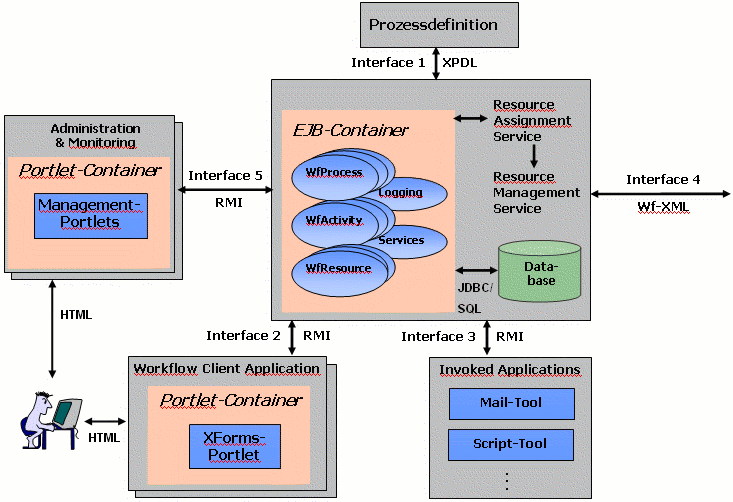|
|
| SF Project Page |
| User Manual (pdf) |
| Maintenance Guide (pdf) |
| Javadoc |
| Download |
| Getting started |

WfMOpen
Welcome to the WfMOpen project
WfMOpen is a J2EE based implementation of a workflow facility (workflow engine) as proposed by the Workflow Management Coalition (WfMC) and the Object Management Group (OMG).
The workflow component is based on a set of JAVA interfaces that define an API for a workflow management facility. The basic "omgcore" interfaces follow OMG's Workflow Management Facility Specification, V1.2 very closely, while making some modifications to adapt the CORBA service to the established design practices for a Java API.
Workflows are specified using WfMC's XML Process Definition Language (XPDL) with some extensions.
Although WfMOpen has its roots in the above mentioned workflow standards, the actual implementation transcends the traditional domain of workflow engines. By design, WfMOpen provides excellent scalability and supports commodity integration technologies, including – but not limited to – SOAP. The workflow component may therefore be used as the core for any process based application implementation and is well suited to provide solutions for BPM (Business Process Management) related jobs.
Structure
WfMOpen consists of several components.

The central component is the workflow engine. It consists of a set of EJBs and some JMS queues packaged as an EJB jar that can be integrated in any application.
The workflow engine can be used without any of the other components of the project provided that all management functions (e.g. importing process definitions) are implemented by your client(s). At least to get started, however, you will propably like to try the web based sample management client that is included in the project.
Also included are some tools that execute activities.
Editing Process Descriptions
Any XPDL 1.0 compliant process editor may be used to create process descriptions. As XPDL is XML, actually any XML editor (and thus any text editor) is sufficient.
It has, however, turned out that a graphical representation of the process is quite helpful. We provide a graphical process editor called "JPEd". See JPEd's home page for more information.
Known References
 uses WfMOpen as part
of its Operational Control System.
uses WfMOpen as part
of its Operational Control System.
 uses WfMOpen together
with Scarab for an
internal issue handling system.
uses WfMOpen together
with Scarab for an
internal issue handling system.
 (subsidiary T-Traffic) uses WfMOpen
in its traffic information subscription system.
(subsidiary T-Traffic) uses WfMOpen
in its traffic information subscription system.
 uses WfMOpen
in its business process driven document management solution
1MAGEwf™.
uses WfMOpen
in its business process driven document management solution
1MAGEwf™.
 uses WfMOpen
in its new J2EE ERP solution.
uses WfMOpen
in its new J2EE ERP solution.
STAIRS (research project) uses WfMOpen for sequencing service calls in its user interface.
 uses WfMOpen as
embedded workflow engine in various projects in
telecommunications and transport and logistics (e.g. for
handling Subscription and Order management Process in a
Subscriber
Management System).
uses WfMOpen as
embedded workflow engine in various projects in
telecommunications and transport and logistics (e.g. for
handling Subscription and Order management Process in a
Subscriber
Management System).
WfMOpen in the press
The Enterprise Open Source Journal had an article about Open Source workflow that covers some aspects of WfMOpen ("Open Source Workflow: A Great Opportunity for Early Adaptors" in issue November/December 2005).
Non-GPL Licensing
If you wish to use WfMOpen in a context where the GPL prohibits its use (e.g. integrated in a proprietary product) you may obtain a commercial license.
Commercial licenses are individually negotiated, following the approach that license costs should not prohibit the use of WfMOpen in your project, but should at the same time reflect a fair share of the effort that you save and the added-value that you gain by using WfMOpen. If you are interested in a non-GPL license, please contact Danet.

|
Project History
WfMOpen is based on the WfMCore project that started in summer 2001 as a development initiative within Danet GmbH. It was triggered by the observation that implementing configurable workflow processes was a reoccurring task in several software development projects.
At that time, a "light-weight" component that provided the workflow engine functions needed in a J2EE environment couldn't be found, so it was decided to develop one. Meanwhile, several implementations of such components (including some Open Source implementations) are available.
Nevertheless, the approach taken has some unique
characteristics that may make it the first choice for a
workflow centered application. In order to verify this
assumption, it was decided to derive an Open Source
version from the WfMCore product and publish it as
"WfMOpen". So, any feedback
on the suitablilty of WfMOpen to solve your workflow
problems would be appreciated.
Special Thanks to 192.168.1.1 & Receive SMS Online